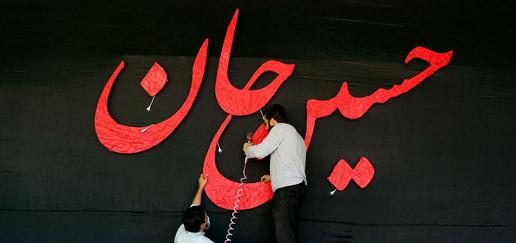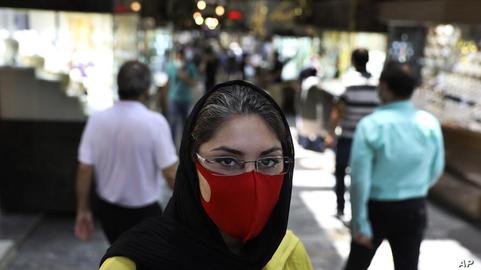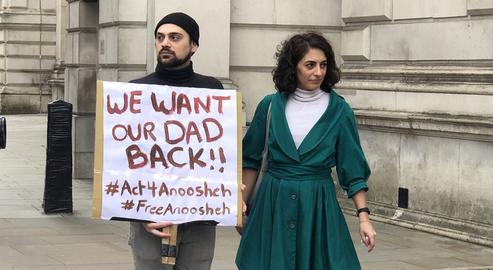Large groups of Shia devotees have gone out on the streets of Iran to mark annual mourning ceremonies, despite warnings from medical experts and Iran’s coronavirus taskforce that such behavior could lead to a spike in Covid-19 cases.
The Islamic lunar calendar month of Muharram started this year on Thursday, August 20. The month is one of Shia Muslims’ holiest times, when people mourn the martyrdom of Imam Hossein, the third Shia Imam, who died in 680 AD. Each year, the mourning is marked by huge ceremonies and processions. Thousands of people usually gather along the streets to watch the procession of men rhythmically beating their chests or using bundles of chains to beat their backs to the beat of massive drums amplified by speakers. Along with the crowds, drums and street processions were banned this year.
But, since Thursday, August 20, despite clear advice and mandatory guidelines issued by the National Coronavirus Taskforce, mourning processions and ceremonies have been held in mosques and on streets across the country.
According to Radio Farda, some Iranian ultra-religious mourning groups and clerics, many of them with considerable political influence, had criticized health authorities for imposing measures that were "too strict" and which they said would interfere with the appropriate observance of the holy anniversary. Some of those objecting against the measures had pledged to ignore them.
Saeed Haddadian, a notorious religious eulogist, said in July that it was necessary for the ceremonies to go ahead with as much splendor as possible, even if that led to the deaths of people. "There are people who are willing to sacrifice their lives for these ceremonies," he said, declaring that he would set his mourning procession in motion in the streets of the capital "under any circumstances.”
Although some photographs have shown people observing health protocols during ceremonies, there are many more photographs and videos online that indicate that social distancing was not practiced, spurred on by the religious leaders who had spoken out against official health guidelines.
One Shia tradition during Muharram is the distribution of food to the needy, which is usually done by setting up stands and stations so that people can have access to what is on offer. This year, however, Ahmad Joneidi, the head of the health ministry’s Center for Workplace Safety, reminded people that setting up such stations is banned. “The Supreme Leader has advised that if the offering can be done in another form then it should be,” he said. “But if it cannot be done in another way, people can cook the food and distribute it to people in their homes under the supervision of health professionals instead of in gatherings. These gatherings increase the chances of coronavirus infection.”
August 22: Doctors' Day and an Appeal for "Traditional Medicine"
Unlike Iran’s first coronavirus wave, the wave that started in June had more fatalities among the 30 to 40-year-old age group, according to President Rouhani. He told the National Coronavirus Taskforce on August 22 that the second wave had affected up to 20 of 31 Iranian provinces. Nevertheless. Rouhani added that “a passionate observance of Muharram mourning ceremonies is a test for all of us” and if, after the ceremonies, no new peak in the pandemic appeared, “everybody will be proud.”
Prior to this, Rouhani had asked his minister of communication to increase the bandwidth of the internet so that mourning ceremonies could be broadcast live on the web.
In Iran, August 22 is National Doctors’ Day, which honors Ibn Sina, or Avicenna as he is known in the West, the great 10th-century Iranian physician, astronomer and philosopher. Iranians marked the occasion online by posting photographs of some of the Muharram religious ceremonies where people disregarded health guidelines, many of them accompanied with the caption: “We shall defeat the health workers this Muharram!” Expectations are that, with packed Muharram mourning ceremonies continuing throughout the month, the number of coronavirus fatalities will once again shoot up.
On the morning of August 22, news outlets also reported that two traditional medicine experts had written to religious authorities. The letter emphasized that one of the important causes of coronavirus fatalities in Iran had been the failure to use the “capabilities of traditional medicine.” They wrote that “if, in addition to widespread promotion of wearing masks and social distancing, we had promoted simple preventive measures such as taking garlic, honey, black cumin and ginger and gargling with saltwater, many of our colleagues and fellow Iranians would still be among us.”
Iran’s Exports Fall 39 Percent Due to Pandemic
Iran’s non-oil exports have shrunk by approximately 39 percent compared with the previous year due to the Covid-19 pandemic, an Iranian export analyst has revealed.
Mohammad Lahouti, the head of Iran’s Export Confederation, said the government had expected about $41 billion of non-oil exports for the current Iranian calendar year starting on March 20, but that so far the figures for the first five months of the current calendar year indicate a decline in exports by at least 39 percent.
Fears in Popular Holiday Destinations
While 26 of 31 Iranian provinces are on high alert, officials of other provinces, including Kermanshah and Khuzestan, continue to issue daily warnings to their people that if they fail to follow health protocols, coronavirus cases could rise and the province might return to a red, or emergency, state of alert.
In the run-up to Muharram religious holidays between August 26 and August 29, there were concerns that provinces that are normally vacation destinations during this period might experience a resurgence in cases. Officials from these provinces have urged people to forgo traveling there if possible. The northern province of Gilan, which was an epicenter of the pandemic at the beginning of the outbreak, is one of them. Noting that people from Gilan who live in other provinces tend to travel to their birthplace during holidays, Dr. Arsalan Zare, governor of Gilan, asked these people to postpone their visits because of the epidemic.
Exams Take Place Despite Fears
After much debate and political upheaval, the nationwide university entrance exams were held between August 19 and August 22 after repeated postponements. Fearful that the exams could accelerate the spread of coronavirus, many prospective participants had repeatedly gone on social media to ask for them to be postponed until the situation improved. In the end, they were ignored, as were medical officials who had supported their requests.
The nationwide exams cover five categories: natural sciences, social sciences, technology and mathematics, arts and foreign languages. According to official figures, 1,247,449 students had registered for the exams but 145,784 of them failed to show up. Many people stated that they had not participated in the exams because they were afraid of contracting coronavirus.
In her daily briefing on August 22, the health ministry spokeswoman Dr. Sima Sadat Lari said that 15 provinces remain in a red, or emergency state of alert, and 11 provinces remain in an orange, or serious state of alert:
- Red: Mazandaran, Tehran, Qom, Golestan, North Khorasan, Ardebil, Isfahan, Alborz, Razavi Khorasan, Kerman, Semnan, East Azerbaijan, Markazi, Yazd and Gilan
- Orange: Fars, Ilam, Lorestan, Hormozgan, Zanjan, Qazvin, West Azerbaijan, Bushehr, Hamedan, Chaharmahal and Bakhtiari and Kohgiluyeh and Boyer Ahmad
In her briefings on August 21 and August 22, Dr. Lari also announced the official coronavirus statistics for the last 48 hours:
- New coronavirus cases: 4,234
- New hospitalizations: 1,778
- Total cases since the outbreak: 356,792
- Total coronavirus tests conducted in Iran: 3,011,310
- Total recovered from coronavirus: 307,702
- New fatalities: 238
- Total death toll since the outbreak: 20,502
This is part of IranWire's coronavirus chronology. Read the full chronology
visit the accountability section
In this section of Iran Wire, you can contact the officials and launch your campaign for various problems




























comments